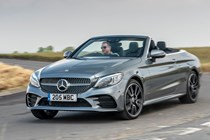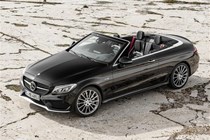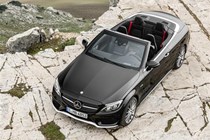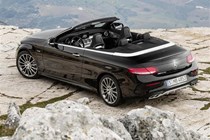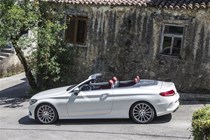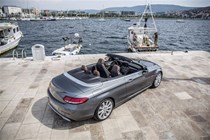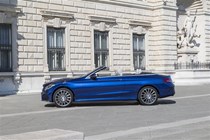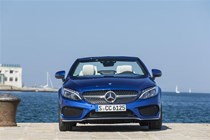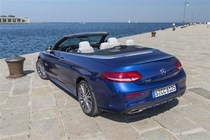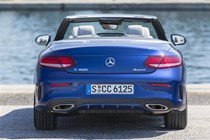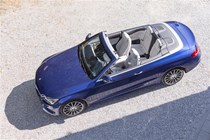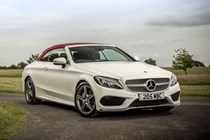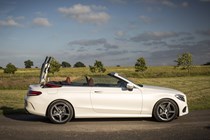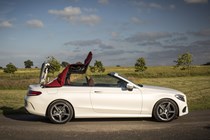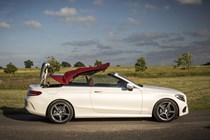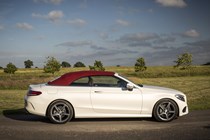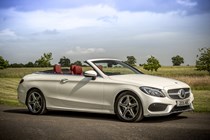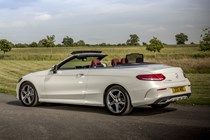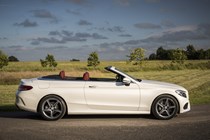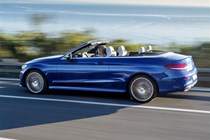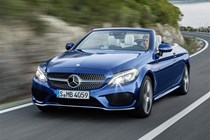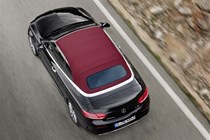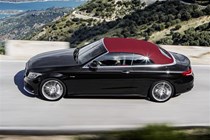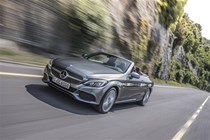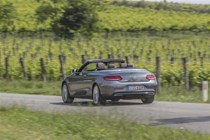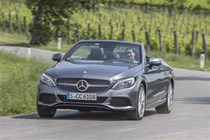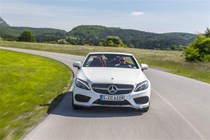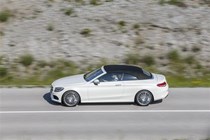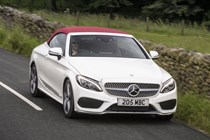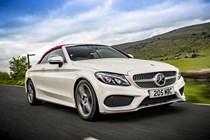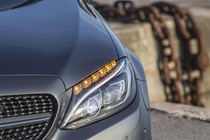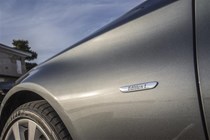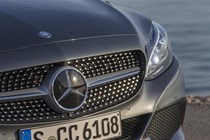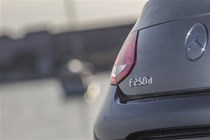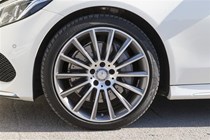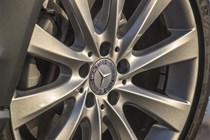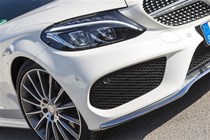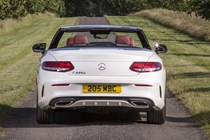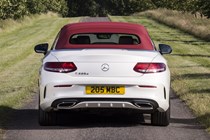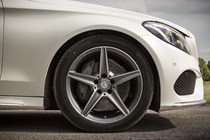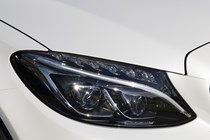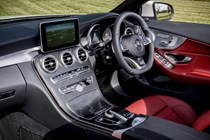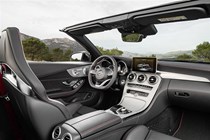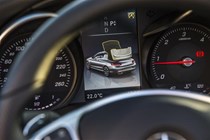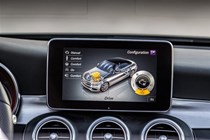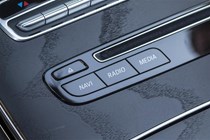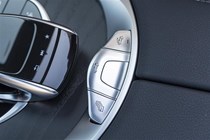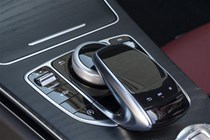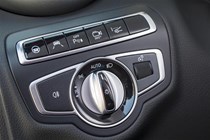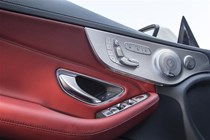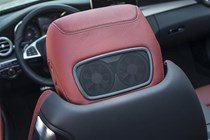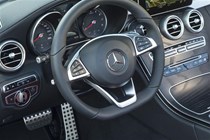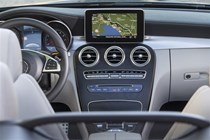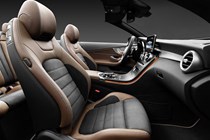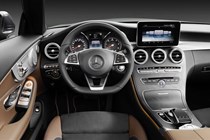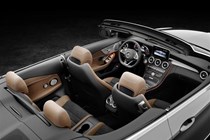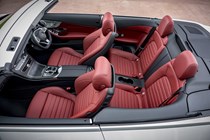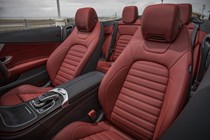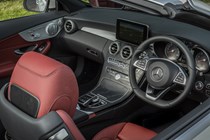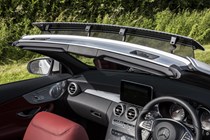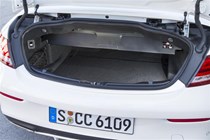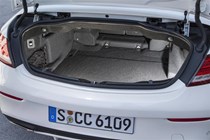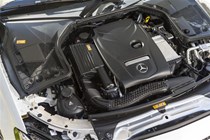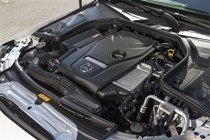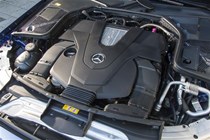
Mercedes-Benz C-Class Cabriolet engines, drive and performance
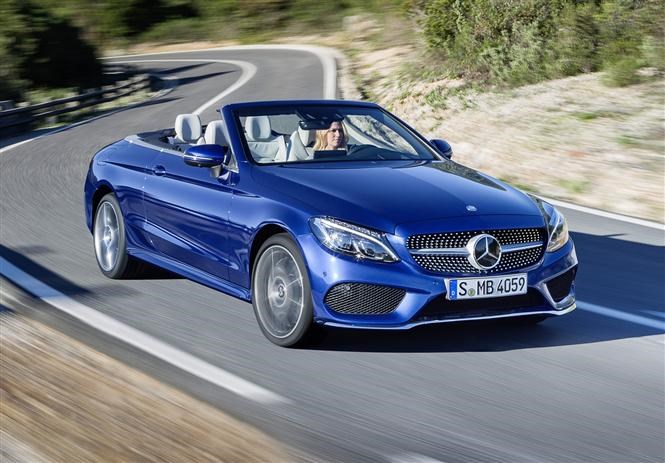
- Two diesels, one mild-hybrid and and a pair of petrols
- Duo of AMG high performance models, too
- None of them could be described as slow
What you want your Mercedes-Benz C-Class Cabriolet to be will determine which engine you choose – and consequently how much performance is on offer – but rest assured, performance is more than adequate in all models. You can get a relatively relaxed petrol model, even one with a manual gearbox if you insist, but each step up yields more mid-range urge, more outright speed and more drama with a surprisingly narrow price gap between models.
Four-cylinder diesels: Still the default choice?
From 2018, the C-Class is offered with two power outputs from the same 2.0-litre twin-turbo engine. C 220 d models now produce 194hp and 400Nm, snapping at the heels of the outgoing C 250 d, and new C 300 d versions upgrade that to 245hp and 500Nm.
9-speed automatic transmission is standard on both, and they’re available with 4Matic all-wheel drive as well.
The new engine is significantly more refined than the previous model, and if you’re buying used looking for a C-Class just a couple of months newer on a 67-plate could make all the difference on a C 220 d.
Two petrols in the regular range – plus a mild hybrid
Two petrol engines are offered in the mainstream C-Class Cabriolet range. Smaller than the badges suggest, they’re a new generation of high-output turbocharged units that, in conjunction with smooth-shifting, nine-speed transmissions are capable of impressive performance and reasomable running costs and emissions.
If you want to change gear yourself, then your only choice is a C 180. This has a 156hp 1.6-litre engine with a single turbocharger, and will hit 62 mph in 8.9 seconds with the manual gearbox. Opt for an auto, and that rises to 9.5 seconds. CO2 and fuel consumption also increase, though in real-world driving the automatic will probably be the better bet.
There’s a big change for the C 200 – it’s a 48V mild-hybrid. The engine is now three-quarters of the displacement, though unlike rivals it retains a full complement of four cylinders. The 1.5-litre twin-turbocharged unit produces 184hp and 280Nm, though as the first EQ-Boost C-Class it benefits from a 14hp electric shove for reduced emissions/improved stop/start and more effective use of energy recuperation. You can get the C 200 with 4Matic, but the batteries do reduce the already-tight luggage space by 25 litres.
Staying old-school, the C 300’s 2.0-litre petrol develops 258hp and 370Nm of torque, and provides a sweet spot in the C-Class range. Taking just 6.2 seconds to breeze from 0-62mph on its way to an electronically governed 155mph top speed, running costs and emissions are far from unreasonable while the performance should satisfy most British drivers.
Mercedes-AMG models for high performance
Want all-wheel drive and more power? There’s a significant performance advantage for the C 43 4Matic Cabriolet, thanks to its turbocharged 3.0-litre V6 petrol engine, mustering 390hp and 520Nm of torque from 2,000rpm. Once again a nine-speed automatic gearbox is the only transmission for this four-wheel drive model.
It too reaches the limited 155mph top speed with ease, accelerating from 0-62mph in 4.8 seconds.
While that’s quick, AMG’s become synonymous with rumbling V8s and the hammer-blow performance that goes hand-in-hand with it.
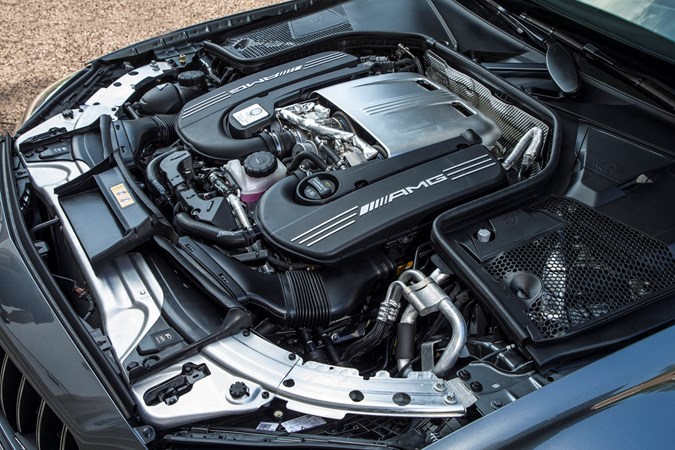
Still badged C 63, a twin-turbo 4.0-litre V8 is under the bonnet – now featuring a pair of power bulges – generating 476hp and 650Nm of torque from 1,750rpm, sending power exclusively to the rear wheels via a seven-speed twin-clutch automatic ‘box.
That means 155mph (limited) and standstill to 62mph in 4.2 seconds, with virtually no turbo lag as it goes about its business.
Want more? Then you need the C 63 S with performance pack, featuring the same engine but now producing 510hp and 700Nm of torque.
That 0-62mph time’s shaved down to 4.1 seconds but the colossal grunt’s administered with a monumental soundtrack from the four tailpipes, proof indeed that turbocharged engines can make the hairs on your neck stand up. If going quickly – and being entertained – is what you need, then place your money here.
Buying used? The diesels are very different…
Whether you choose the C 220 d or the brisker C 250 d, both are powered by the same 2.1-litre diesel motor, tuned differently to vary performance.
Producing 170hp, the C 220 d musters 400Nm of torque from just 1,400rpm, making it a flexible unit. A six-speed manual is the standard transmission, with a nine-speed automatic being the optional – and preferable – gearbox.
Both reach 143mph, while the manual completes the 0-62mph sprint in 8.3 seconds. Choose the auto and it’ll shave a further tenth of a second off.
Stick to 17-inch wheels and the manual model is the most efficient in the range with claims of 62.8mpg and 116g/km of CO2.
Automatic versions can be up-specced further with the addition of the 4Matic four-wheel drive system: top speed drops to 140mph but the 0-62mph is edged down to 8.1 seconds.
The more powerful C 250 d is automatic-only and delivers 204hp and 500Nm of torque at 1,600rpm to the rear wheels.
That power increase is telling with a top speed of 153mph and just 7.2 seconds required to reach 62mph from a standstill.
It too is flexible and very linear in its delivery, making it a sensible choice. It doesn’t even sound as agricultural as it does in other models, a bonus when the roof’s down. As a ‘regular’ choice, this is our pick of the range.
Prior to the 2018 model year, the entry-level engine is the petrol C 200, serving up 184hp and 300Nm of torque at a diesel-like 1,200rpm; there’s also a C 300 option with 245hp. Both are 2.0-litre, four-cylinder turbo units.
While the six-speed manual version tops 147mph, those fitted with the nine-speed automatic are 1mph shy of that. The tables turn for the 0-62mph sprints: the manual takes 8.2 seconds, to the automatic’s 7.8. The C 300 drops that to 6.4 seconds
Driving the C-Class Cabriolet – a car with diverse characters
- Fine mix of comfort and sportiness
- AMGs are docile, savage when provoked
- Superior traction with 4Matic models
Several cars claim to alchemise comfort and roadholding but few achieve it to the same level of success as the Mercedes-Benz C-Class Cabriolet.
Even the riotous Mercedes-AMG C 63 versions can be made to deliver a fairly compliant ride quality thanks to the optional adaptive suspension system – a feature we would recommend for any of the Cabriolet range.
As per the Coupe derivative, the handling of the Mercedes-Benz C-Class Cabriolet range leans towards a sportier set-up thanks to employing 15mm lower suspension than that of the Saloon and Estate versions.
The inherent firmness of the lowered arrangement is more apparent on the standard suspension, but Mercedes’ Airmatic option allows that to be dialled out or amplified depending on your preferences, thanks to its adaptive nature.
With the faster versions the ride can get a little choppy on some poorly-surface motorways, though. This won’t annoy the driver too much but passengers may be reluctant to travel for too many hours.
Flick between Comfort, Sport and Sport+ modes – or an even more hardcore Race setting on the C 63 models – to vary not just the adaptive dampers, but also steering weight, throttle response and how readily the automatic transmissions swap ratios.
Typical of other Mercedes models, the C-Class Cabriolet’s steering – including the AMG versions – is light but at low speeds and weights up in a progressive, linear fashion as pace and wheel angle increase. We wouldn’t mind an increase in the degree of feel at the helm, though.
With the exception of the Mercedes-AMG C 43 Cabriolet, the C-Class is rear-wheel drive unless you specify 4Matic all-wheel-drive; available on more powerful petrol and diesel models (but not the V8 C 63). It adds some security in poor weather conditions and extra traction in snow.
All C-Class Cabriolets display a pleasing degree of sportiness, although we noticed a degree of body flex over poor road surfaces. This isn’t an issue in the ‘regular’ versions, but the hardcore C 63 and C 63 S models suffer a little in this regard, being noticeably less predictable through corners than the Coupe.
That said, the experience is amplified immeasurably by hearing the popping and gargling of the V8’s exhaust without a roof suffocating the sound, but it’s a proper sports car which will light up its rear tyres and rotate itself through corners, the trick differential metering out the colossal power in the most effective manner. Joyous.


